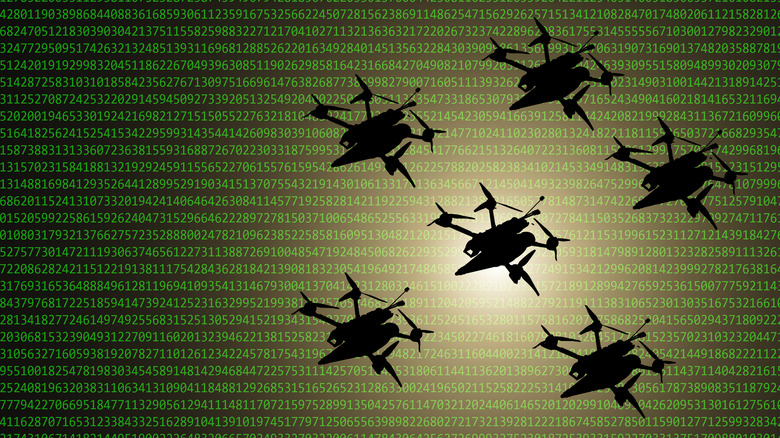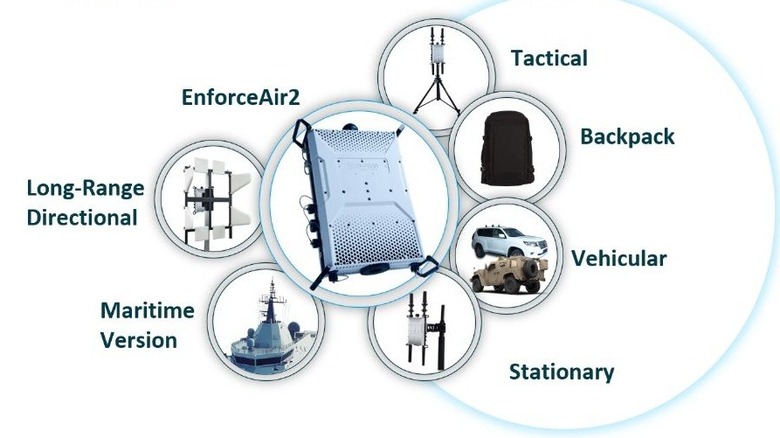This New Military Defense System Can Defend Against Drones Without Use Of Force
One of the fastest-growing trends changing military and intelligence operations is the proliferation of military-grade drones. Cheap, easy to transport, and readily available, drones play an increasingly critical role on the battlefield. And while questions over how the U.S. deals with drones on the battlefield are well-founded, an equally pressing question may be how it can neutralize the threat on U.S. soil. As it stands, America's military bases and critical infrastructure are extremely susceptible to drones.
In 2024 alone, the U.S. detected 350 drone incursions across 100 military bases. A burgeoning anti-drone industry is emerging as a response, with some experts predicting the market to grow from $4.5 to $14 billion by the end of the decade. The U.S. military, for its part, is actively seeking solutions to the unique challenges posed by drones. In the short term, the Pentagon will deploy 'flyaway kits' to quickly equip bases with anti-drone detection and countermeasures.
Unfortunately, most of the common anti-drone measures in such kits are impractical for the sensitive locations where they are most needed, such as military bases, nuclear sites, airports, and densely populated urban areas. The DoD hopes to solve this problem through its Replicator 2 Project. Currently in its solicitation phase, the Defense Innovation Unit's initiative aims to develop low-collateral drone detection and mitigation systems. One company that may be on the inside track to satisfying these criteria is D-Fend Solutions, whose EnforceAir2 system uses cyber-takeover technology to mitigate drone threats without force.
Challenges
Based out of Israel, D-FEND Solutions has developed a cyber defense tool it believes will become the blueprint for anti-drone defense systems. Considering their diminutive size, many might consider drones an easy threat to mitigate, but in fact, they present unique challenges for governments and militaries that must neutralize drones without damaging local telecommunications or infrastructure. There are several methods for disrupting drones. The first is jamming, in which large radio frequencies disrupt the signal between a drone and its controller, forcing the drone to land or return to its launch point.
While often hailed as effective, critics note that jamming can disrupt local radio waves, making them dangerous in communication-needy locations like military bases and airports. GNSS spoofing, a similar tactic using false satellite signals to redirect a drone's directional systems, suffers from the same issue, often disrupting local navigation systems. Likewise, electromagnetic and high-power microwave pulses can cause major damage to local technology and infrastructure.
A more direct approach is through kinetic disruption, in which drones are physically neutralized through missiles, bullets, nets, or other projectiles. The pros and cons of such systems are obvious. While bringing down a drone via missiles quickly neutralizes a threat, it also creates the potential for massive collateral damage from either falling debris or a misfired projectile, as when twelve were injured when Saudi air defenses destroyed a drone near Yemen in 2022. High-energy lasers, which can burn through a drone, are replete with logistical challenges, as uncertain sightlines and poor weather conditions reduce effectiveness while falling debris or poorly targeted systems could cause significant damage in densely populated areas.
Cyber takeover: a potential solution
On the cutting edge of anti-drone defenses is D-Fend Solutions' EnforceAir2 system, which proposes to detect, identify, and hijack drones within an operational radius over 2.5 miles. The easiest way to understand D-Fend's system is to view it like a portable router that hacks into a drone by intercepting its radio frequency, cutting off the communications between the pilot's controller and the craft. After hijacking these frequencies, the EnforceAir2 redirects the drone to a preset landing location for further examination.
According to the company, the benefit of D-FEND's 'cyber-takeover' device is that it mitigates collateral damage risks inherent in missiles, GNS spoofing, and electromagnetic pulse defense systems. By landing the drone in a designated area, the EnforceAir2 allows users to identify and examine the drone. This type of attribution is not only a powerful intelligence resource but also allows users to return harmless drones to their controllers. The company also states that its more targeted frequency won't create mass communications issues, making anti-drone defense much more practical in areas like airports and military bases where radio frequency communications are critical.
Intended for military, homeland security, and law enforcement end users, the EnforceAir2 comes in a variety of bundles and configurations, including tripod setups, vehicle mounts, fixed installations, and even backpack-portable kits. Advertised as a flexible solution for a range of locations, the device delivers 360-degree coverage, a frequency compatibility ranging between 400MHz and 6GHz, and 2.5 hours of battery life. To expand area coverage, D-Fend offers its Multi-Sensor Command & Control system, which enables its customers to link multiple EnforceAir kits from a single server.


